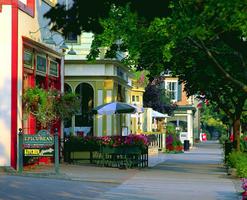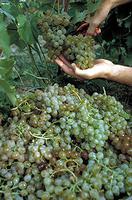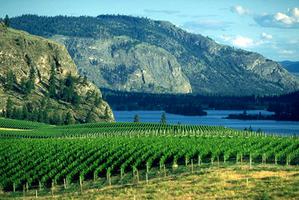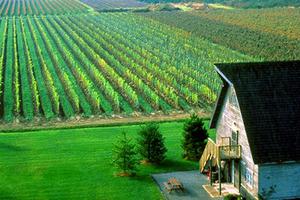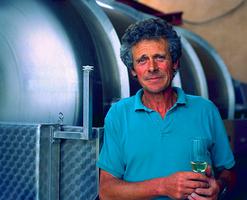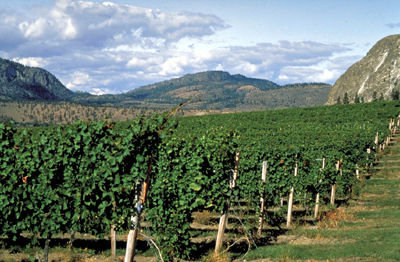Wine Touring
Wine has been made commercially in Canada for over 150 years, but only in the latter part of the 20th century have Canada's vineyards become popular tourist destinations. Before 1974 in Ontario, for instance, Bright's Winery (now part of Vincor) and Barnes (1873-1988) offered tours of their facilities and tasting rooms, but few visitors took advantage of the offers. A tripling of wine-industry employment figures between 1990 and 1995 in Ontario and BC, Canada's two most prolific wine-growing provinces, is partly attributed to the marked growth in wine tourism. The increasing popularity of wine tourism is in response to a number of factors, first among them the striking improvement in the quality of wines produced.
For many years, Canadian wines were made from native grape varieties not capable of producing fine-quality wines. Improved vineyard management techniques, advances in technologies of plant health, and an increased demand for good table wines encouraged growers to replace native varieties with classic European grape varieties. With better quality grapes, winemakers were able to produce high-quality wines.
Financial incentives offered by governments to wine producers have resulted in improved touring and tasting facilities. The signing of the Free Trade Agreement with the United States (1988-90), the Ontario Winery Adjustment Program (1990) and the British Columbia Grape and Wine Adjustment Program (1988) allowed several short-term programs to be put in place to support industry-wide restructuring. No longer protected, Canadian wine was taxed at a rate designed to equal the taxes paid on imported wines. Revenue thus generated for both provincial and federal governments was made available to producers to cover capital infrastructure expenditures. Wineries able to produce matching funds expanded and improved their tasting rooms and visitor facilities, making them comparable to those found in other wine-touring areas of the world.
Wineries, often represented by industry associations and supported by government policies, advertised to promote wine touring. Included in the money provided through winery adjustment programs were allocations for generic (industry-wide) marketing. In Ontario, for instance, the Ontario Wine Council, an association of wineries working together to promote and improve the industry, produced a television promotion entitled "We're ready when you are..." depicting a modern industry with high-quality - but undiscovered - wines. Similar funding in BC prompted the formation of the British Columbia Wine Institute, also a member-driven organization whose mandate is to establish growing and production standards, create a better environment for the promotion of BC wines, and conduct and disseminate research.
Tourist market studies show that the contemporary traveller prefers educational travel to a passive sightseeing experience. Wine touring, whether highly organized or self-directed, offers scope for learning about the technical aspects of winemaking and the cultures of wine-producing places. It allows the traveller to encounter a wide variety of landscapes without sacrificing the luxuries of convenient accommodations and good food. Practical consumer benefits include the chance to sample wines before purchase and to buy special lots available only at the winery.
Package Tours
Visitors to Germany have steamed up the Rhine or Mosel for years, making the occasional stop at a wine village along the way. Many of these tours were orchestrated by enterprising tour operators. Increasingly, as Canada's wines (particularly icewine) have gained world renown, international tour operators have turned to Ontario and British Columbia's wine regions as package-tour destinations.
Wine country has also been the destination for corporate groups, gourmet wine and food clubs and hospitality associations. To accommodate visitors, wineries have put together packages of their own and partnered with other hospitality organizations to provide visitors with events, accommodation, food and wine - all in one price.
Inniskillin Winery, at Niagara-on-the-Lake, Ont, devised a successful package tour (Elegant Traditions) which included a ticket to the theatre (Shaw Festival), a room at a historic hotel (Prince of Wales), dinner and breakfast, a free tasting, a wine tote and a self-guided tour.
Festivals and Special Events
Wine festivals have been held in Canada's wine regions since the early 1950s. The Okanagan Wine Festival and the Niagara Grape and Wine festival attract thousands of visitors to their multi-day harvest events. In addition, events are scheduled every weekend in summer (jazz concerts, Shakespeare in the vineyard, bicycle vineyard and winery tours, helicopter rides, barrel-making demonstrations, art exhibits, picnics, dinners, seminars, escarpment and mountain hikes). For winter and spring there are icewine picking parties, complete with mulled wine, icewine and truffles, stemware seminars and icewine galas. These and other events mean that wine travel - even in Canada - is year round.
Planning a Trip
Wine country touring offers travellers' aesthetic experiences, opportunities to indulge historical and cultural interests, viticultural and oenological information (the growing of grapes and the making of wine), and the chance to speak to those who are directly involved in making wine.
Both British Columbia and Ontario have developed carefully signed Wine Routes and wine maps to guide tourists through wine country. Large operations tend to have more organized and sophisticated facilites, including multimedia centres that introduce the novice to winemaking principles. The smaller the operation, however, the more likely the traveller is to meet winemaker and vineyard manager. Tourists choose their stops in relation to their own schedule and interests.
Wine-touring etiquette centres on the exercise of the tasting and the seriousness with which it is conducted. Wine is best tasted in an atmosphere free of competing odours (smoke, perfume, gum or candy), distracting noise and unnecessary conversation. Spitting (to preserve sobriety and maintain sensitive taste buds) is a recognized part of the process. Tacit acknowledgement that the winemaker is an artist as well as a technologist or scientist informs the tasters' comments.
Ontario
Ontario's wine country (made up of the Niagara Peninsula, Lake Erie North Shore and Pelee Island) is located within the so-called Carolinian Zone - an exceptionally mild corridor of land along the shores of Lakes Erie and Ontario with a habitat similar to the American Carolinas. Often called eastern Canada's banana belt, it contains more species of rare, threatened and endangered plants and animals than any other place in Canada.
The Niagara Peninsula, the largest of Ontario's wine regions, lies on the same latitude as Florence (nothern Italy) and enjoys growing conditions similar to those in Burgundy (east-central France). Lakes Erie and Ontario form its southern and northern boundaries moderating its climate. Lake Erie North Shore, located in southwestern Ontario, has the most sunshine hours in Canada. Its grape-growing area stretches along the bow-shaped shoreline of Lake Erie. Pelee Island, marginally nearer the equator than Rome, is Canada's most southerly point. It enjoys a longer growing season than any other wine region in Canada. Situated in Lake Erie 25 km off the mainland, it is also a sanctuary for wildlife and plant life.
Ontario is known for its classic Riesling, Chardonnay, Cabernet Franc, Gamay Noir and Baco Noir. The styles vary from very dry to sweet late harvest, including the latest harvest of all - icewine.
British Columbia
BC has four distinct wine regions: the Okanagan Valley, Similkameen Valley, Fraser Valley and Vancouver Island. The 100-mile Okanagan Valley is the largest and oldest wine- growing region in BC. Its mountain slopes and clay cliffs frame picturesque Okanagan and Skaha lakes - a vacationer's haven. This region is best known for its French and Germanic whites: Chardonnay, Riesling, Pinot Blanc, Gewurztraminer, Auxerrois and Ehrenfelser. The south end of the valley, with less than 15 cm of rainfall a year, is the only classified desert area in Canada. Here, in irrigated vineyards, some of the provinces' best reds originate: Merlot, Bacchus, Maréchal Foch and Baco Noir.
The striking Similkameen Valley to the west is high desert cattle country in the lee of the Coast Mountain range. The Fraser Valley, a half hour drive east of the city of Vancouver, is the largest farming region in the province and home to 20 hectares of vineyards. Vancouver Island, just off the coast, is BC's newest wine-growing region. Near the town of Duncan, an hour's drive from Victoria, are hillside vineyards that wind along country lanes linking historic towns.

 Share on Facebook
Share on Facebook Share on X
Share on X Share by Email
Share by Email Share on Google Classroom
Share on Google Classroom
